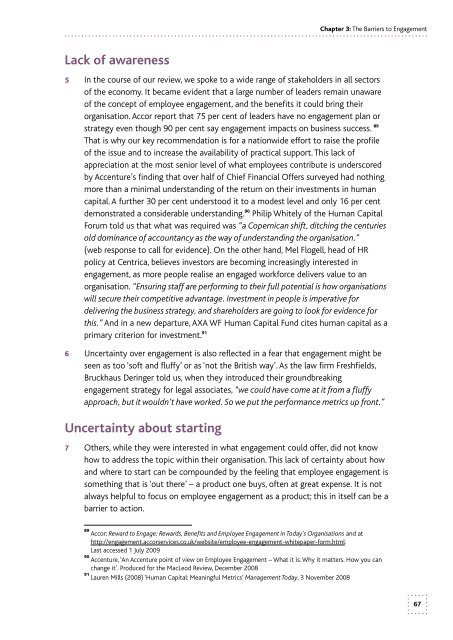3ytgeaf
3ytgeaf
3ytgeaf
You also want an ePaper? Increase the reach of your titles
YUMPU automatically turns print PDFs into web optimized ePapers that Google loves.
Chapter 3: The Barriers to Engagement<br />
Lack of awareness<br />
5 In the course of our review, we spoke to a wide range of stakeholders in all sectors<br />
of the economy. It became evident that a large number of leaders remain unaware<br />
of the concept of employee engagement, and the benefits it could bring their<br />
organisation. Accor report that 75 per cent of leaders have no engagement plan or<br />
strategy even though 90 per cent say engagement impacts on business success. 89<br />
That is why our key recommendation is for a nationwide effort to raise the profile<br />
of the issue and to increase the availability of practical support. This lack of<br />
appreciation at the most senior level of what employees contribute is underscored<br />
by Accenture’s finding that over half of Chief Financial Offers surveyed had nothing<br />
more than a minimal understanding of the return on their investments in human<br />
capital. A further 30 per cent understood it to a modest level and only 16 per cent<br />
demonstrated a considerable understanding. 90 Philip Whitely of the Human Capital<br />
Forum told us that what was required was “a Copernican shift, ditching the centuries<br />
old dominance of accountancy as the way of understanding the organisation.”<br />
(web response to call for evidence). On the other hand, Mel Flogell, head of HR<br />
policy at Centrica, believes investors are becoming increasingly interested in<br />
engagement, as more people realise an engaged workforce delivers value to an<br />
organisation. “Ensuring staff are performing to their full potential is how organisations<br />
will secure their competitive advantage. Investment in people is imperative for<br />
delivering the business strategy, and shareholders are going to look for evidence for<br />
this.” And in a new departure, AXA WF Human Capital Fund cites human capital as a<br />
primary criterion for investment. 91<br />
6 Uncertainty over engagement is also reflected in a fear that engagement might be<br />
seen as too ‘soft and fluffy’ or as ‘not the British way’. As the law firm Freshfields,<br />
Bruckhaus Deringer told us, when they introduced their groundbreaking<br />
engagement strategy for legal associates, “we could have come at it from a fluffy<br />
approach, but it wouldn’t have worked. So we put the performance metrics up front.”<br />
Uncertainty about starting<br />
7 Others, while they were interested in what engagement could offer, did not know<br />
how to address the topic within their organisation. This lack of certainty about how<br />
and where to start can be compounded by the feeling that employee engagement is<br />
something that is ‘out there’ – a product one buys, often at great expense. It is not<br />
always helpful to focus on employee engagement as a product; this in itself can be a<br />
barrier to action.<br />
89<br />
Accor: Reward to Engage: Rewards, Benefits and Employee Engagement in Today’s Organisations and at<br />
http://engagement.accorservices.co.uk/website/employee-engagement-whitepaper-form.html.<br />
Last accessed 1 July 2009<br />
90<br />
Accenture, ‘An Accenture point of view on Employee Engagement – What it is. Why it matters. How you can<br />
change it’. Produced for the MacLeod Review, December 2008<br />
91<br />
Lauren Mills (2008) ‘Human Capital: Meaningful Metrics’ Management Today, 3 November 2008<br />
67


